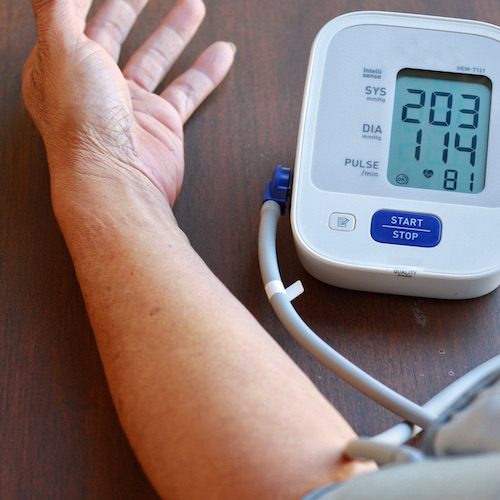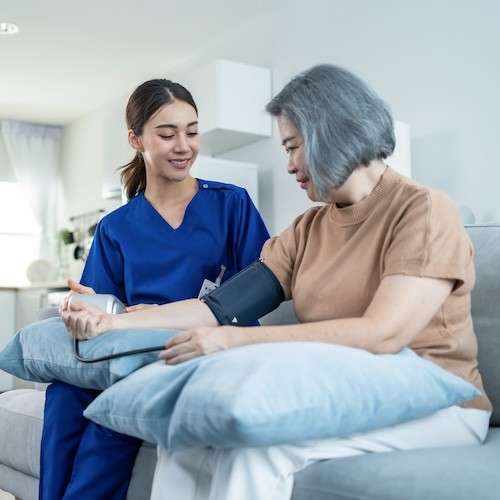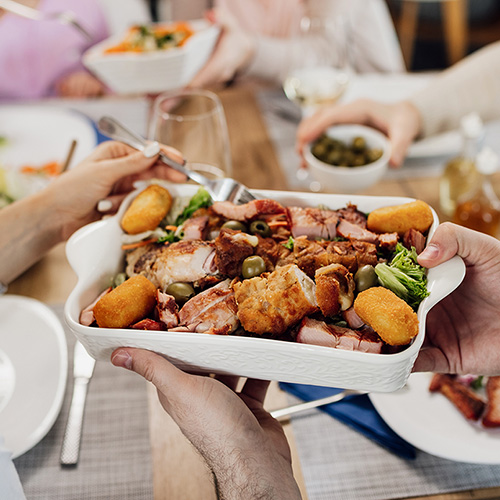Severe headaches, back pain or discomfort, a heart murmur, vision problems, loss of coordination, and ear ringing are all symptoms of high blood pressure that can trigger fear. But don’t be alarmed. Keep your cool! Know that you can be in full command of the situation.
A quick first-aid will help you avoid complications and save your life. Using reliable medical information can provide you with the knowledge you need to deal with high blood pressure emergencies.
Blood pressure is the measurement of force that blood exerts on the artery walls as the heart pumps. Normal blood pressure is 120/80 mm Hg (120 is the systolic pressure. 80 is the diastolic pressure). Systolic blood pressure measures the pressure in your arteries as your heart pumps blood. The lower number, known as diastolic blood pressure, measures the pressure in your arteries when your heart rests between each pump. Normal blood pressure is critical for efficiently transporting nutrients to all organs.
Hypertension starts when the systolic reading is 130 mmHg or higher while the diastolic reading exceeds 90 mmHg. When your blood pressure reading is beyond normal, you might need to call the physician immediately.
It is necessary to remain calm while waiting for a healthcare professional. Maintain your composure and follow the steps outlined below.
Check Your Blood Pressure Accurately.
Take the test only after you’ve rested; remember that physical activity and stress can affect your blood pressure reading. Here’s how your companion can manually check your blood pressure.
- Make sure your feet are flat on the ground and your arm is at chest level.
- Locate your pulse by lightly pressing your index and middle fingers to the inside center of your elbow bend.
- Place the stethoscope’s bell over the brachial artery.
- Inflate the BP cuff until no sounds are heard through the stethoscope.
- Deflate the blood pressure cuff slowly and listen for the Systolic Reading (This may resemble a tapping sound)
- Continue to listen as the BP cuff pressure drops and the sounds fade while waiting for the diastolic reading.
Look For Proper Ventilation.
Open the windows to allow more air into your room, or you could turn on the air conditioner if you have one. At this point, you may want to avoid hot spaces first, as extreme heat can raise blood pressure.
Heat and humidity can increase the skin’s blood flow. High temperatures cause the heart to beat faster and blood circulation to speed up twice as it would on an average day.
Sit Still, Breathe Deeply.
Select an appropriate sitting position. Rest comfortably while maintaining proper airflow. Breathe deeply and relax.
Strengthening your breathing muscles may help you avoid hypertension. Slow breathing exercises stimulate the parasympathetic nervous system, which also helps slow down the heart rate and dilates blood vessels, bringing down your blood pressure overall.
Think Positive Thoughts.
Know that help is on the way. Negative thoughts may lead to an elevation in your blood pressure. It could raise blood pressure to as high as 30 mmHg. This is because when you are stressed, your body releases cortisol. Cortisol, also known as the stress hormone, increases your body’s temperature and blood pressure.
Take Your Maintenance Medication.
Forgetting your prescribed drug may be the reason for your blood pressure fluctuation. It is unsafe to discontinue medication without first consulting your physician. Aside from spiked-up blood pressure, you may also experience withdrawal symptoms such as anxiety, irritability, shaking, and a migraine.
Don’t Forget To Empty Your Bladder.
Holding your bladder does not only harm not only your kidneys but also your blood vessels. Don’t forget to empty your bladder while waiting for an ambulance or a physician. According to research, holding your urine for at least 2 hours raises systolic and diastolic blood pressure. It is recommendable to have a clear bladder in an emergency.
Remember to monitor your blood pressure after you’ve emptied your bladder. A full bladder can affect the precision of your blood pressure reading, raising it by 10-15 points.
Drink Ample Amount of Water.
Drink plenty of water while you wait for the physician. Check to see if your urine is clear. Chronically dehydrated people are more likely to have hypertension or high blood pressure. When the body’s cells become dehydrated, the brain instructs the pituitary gland to release vasopressin, a chemical that causes blood vessels to shrink. This raises blood pressure, resulting in hypertension.
Take a Warm Bath or Shower.
According to studies, taking warm baths may be helpful for those with high blood pressure. The steam associated with warm bathing can contribute to heart health by helping lower blood pressure. Staying in your shower or bath for at least 10 minutes could significantly help lower your blood pressure by reducing muscle tension. When your muscles are relaxed, your blood vessels become more dilated. A wider blood vessel means better circulation.
If you can’t take a shower you could try rubbing your body with a wet sponge. Take note of your pulse points during your sponge bath. These are your wrists, nape, and back of your joints.
Be Honest With Your Physician.
Depending on the circumstances, you can take the patient to the emergency room or schedule an appointment with a physician for the next day.
When speaking with your physician, don’t skimp on the specific details. It would be beneficial to inform him of your activities before your emergency. You can discuss with him your particular diet and lifestyle. Be thorough and tell him about all the symptoms you are experiencing right now.
References:
https://www.medicinenet.com/how_to_lower_my_blood_pressure_immediately/article.htm
https://hhma.org/how-can-i-lower-my-blood-pressure-immediately/
https://www.ncbi.nlm.nih.gov/pmc/articles/PMC3383137/
https://www.webmd.com/hypertension-high-blood-pressure/how-to-lower-blood-pressure
https://www.ahajournals.org/doi/pdf/10.1161/01.HYP.14.5.511]








